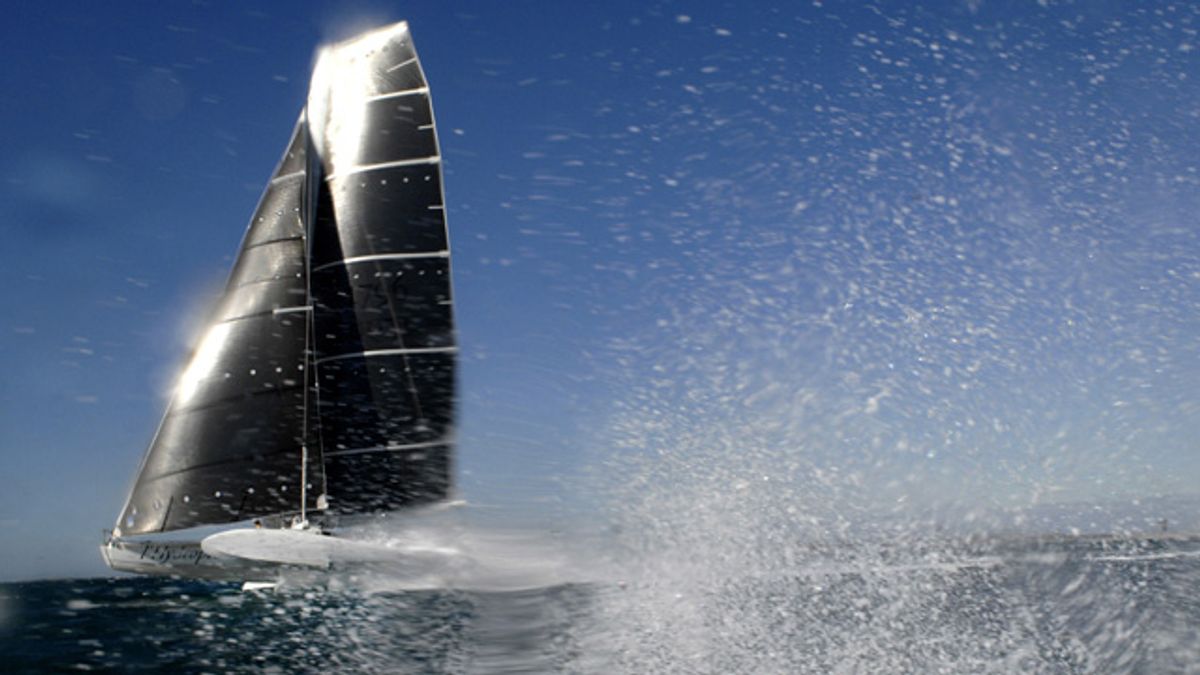This segment is part of the IEEE Spectrum series “Fastest on Earth.”
Fastest Sailboat: Alain Thébault’s Hydroptère
TRANSCRIPT:
Susan Hassler: What can you say about a 25-year-old boat that flies? That it’s fast. It’s French! And with an average speed of just above 50 knots—that’s 57.6 miles per hour—it holds the current world speed record for sailing. Giselle Weiss takes us aboard, in Lorient, France.
[cheering sounds, Hydroptère team celebrating in 2009]
Giselle Weiss: Named Hydroptère, the boat is the brainchild of Alain Thébault, a self-titled self-made man who grew up in an orphanage in Lorient, on the Brittany coast. Lorient is where Hydroptère is moored. One promising day in May, Thébault invites me to go for a sail. A dinghy ferries a small group of visitors out to the craft and we scramble aboard.
[splashing, voices]
Giselle Weiss:Hydroptère is a trimaran. Think catamaran with an extra longer hull in the middle. But Hydroptère has something more—a pair of winglike appendages, called “hydrofoils,” under the outrigger hulls. When the wind reaches 12 knots, equivalent to a light breeze, the foils produce enough lift to raise the 6-ton craft. Only the wingtips remain in the water.
[water sloshing]
Giselle Weiss: It was Thébault who piloted Hydroptère to victory in 2009. But today, copilot Jacques Vincent is at the steering wheel. Beside him, other crew members scan the water for clues and adjust the mainsail as the speed picks up, using cranks called “coffee grinders.”
[cranking noises]
Giselle Weiss:Hydroptère supports a maximum of 11 crew members. For races, that means nine on deck and two in the cabin watching the computers that collect data from stress sensors placed all over the boat.
Alain Thébault: Okay! Là, vous pouvez vous mettre en position de basse. On va bientôt décoller!
Giselle Weiss: Thébault tells the guests to duck down. The hulls have risen three meters above the water. The speedometer registers 23 knots. Thébault has compared early trials of Hydroptère on rough seas to being in a washing machine. But today, the ride feels great, as long as I sit still. Thébault himself bounds effortlessly across the trimaran’s trampoline deck like an astronaut on the moon. After about 10 minutes, the boat slows.
Alain Thébault: Donc, là, on va virer. Et on va chercher un peu d’air.
Giselle Weiss: The team fiddles with the sails to chase a little more wind. But the air has calmed. We cruise pleasantly back to harbor.
[quiet sailing sounds]
Giselle Weiss: Thébault began drawing sketches of the boat that would become Hydroptère in the early 1980s. In 1984, at the age of 22, he found his way to champion yachtsman Éric Tabarly and showed him his design. Impressed, Tabarly asked where Thébault was living.
Alain Thébault: I answered, “I’m living in my car!”
Giselle Weiss: Tabarly gave Thébault shelter, encouragement, and friendship. By 1985, Thébault had developed a scale model. The availability of carbon-fiber materials and the aid of the French aeronautical industry helped to advance the project. But hard work, and many failures, lay ahead.
Alain Thébault: When you want to break a record, first you break the boat. We crashed four times! It was a long process, and you need a stone spirit.
Giselle Weiss: A big challenge for Hydroptère is how to balance strength and lightness. In 2008, sailing off the coast of southern France, the boat briefly touched 61 knots—that’s 70 miles an hour—but flipped over and was towed back to shore.
Alain Thébault: The design of the shape of the hydrofoil was not good, and we lost the lift and suddenly we capsized.
Giselle Weiss:Hydroptère went into dry dock for redesign and rebuilding. A year later, the boat raced to victory in the Mediterranean, breaking two world records in the space of three months.
Alain Thébault: For us, it was really great.
Giselle Weiss: Thébault’s next big dream is to break the transatlantic record in 2014. For that, he will need a new boat, now being developed in France. The idea of winged boats goes way back. But none has yet matched Hydroptère. When Thébault was 10, he says, and longing for escape, he had two books: The Little Prince, by Antoine de Saint-Exupéry, and the Tales of Aladdin.
Alain Thébault: I was dreaming about a flying carpet. Now I’m lucky, because I fly it.
Giselle Weiss: I’m Giselle Weiss.
Music: “La Mer”
La mer
Qu’on voit danser le long des golfes clairs
A des reflets d’argent
La mer
Des reflets changeants
Sous la pluie….
Susan Hassler: On a program about the fastest things on earth, we’ll note that “La Mer” may be the fastest-written song ever. In 1943, the composer and singer Charles Trénet wrote it in 10 minutes, on toilet paper, en route by train from Paris to the French coast.
Music: “La Mer” continues.



